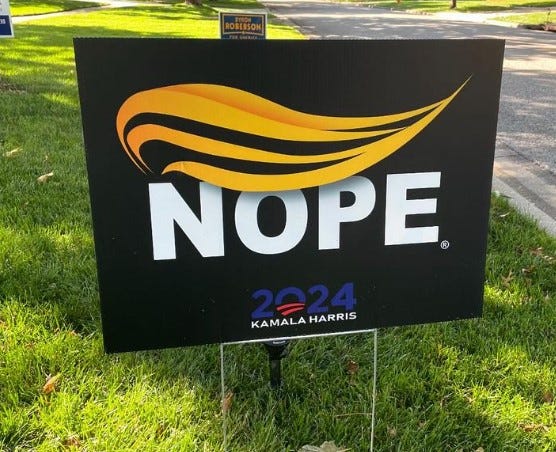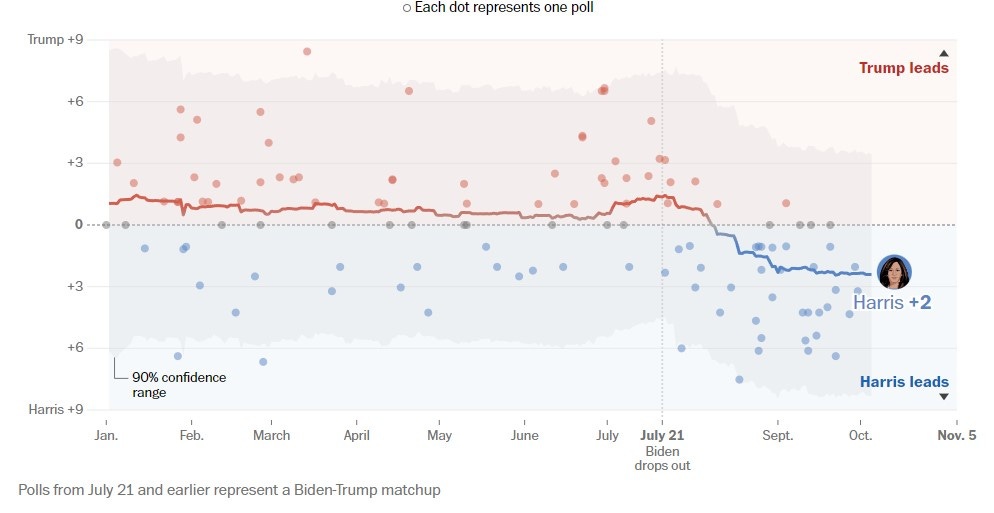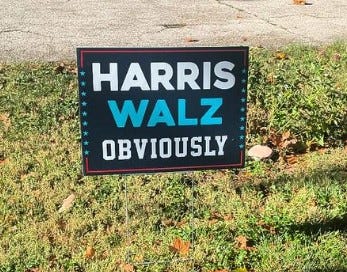Political punditry: Why Trump won't win, revisited
If Harris nabs just half of the last voters to choose, she’d sail in with an outright majority and a 2.6-point win, probably landing her clear of the swing state shift.
In January, I offered my analysis of the forthcoming Presidential election under the headline as above —less the “Revisited.” Five dog years later, the election landscape has changed dramatically—yet not much at all. Trump is still, well, Trump. J.D. Vance, a slightly more couth Trump, has been appended. Biden has been mercifully subtracted after the June 27 debacle, and Harris and Walz added. And the polls still say either side has about an equal likelihood of prevailing. Oh, my.
I’m not a card-carrying pundit, but I do consume an unhealthy diet of political news, the commentary du jure, ultimately leavened with my own, informed analysis. With this as preface, I offer a refreshed take on where we are, where I think this is headed, and why.
First, I gave myself a pat on the back—figurately, of course—for originally using the headline “Why Trump won’t Win,” which I can repeat today, rather than “Why Biden will win,” which, of course, has not stood the test of time. Then, moving to the substance, before adding some additional criteria, I revisit the six factors that I speculated would mitigate against a Trump win. They were:
Trump has never won the popular vote. That’s why “swing states” are so important, ‘cause it’s the Electoral College that matters. The polls have the swing states—you know which they are—almost all within the margin of error.1
Everyone who loves Trump is already counted. True then, true now. However, there are relatively few potential voters who claim not to be Trump groupies but somehow claim to be “undecided.” In critical states, they could make a difference.
Iowa was not a big Trump win. In later primaries, votes for Nikki Haley, in particular, supported the premise that there were a meaningful number of Republicans who wanted an alternative to Trump. However, more recent polling suggests most of these rebels seem to have come back into the fold, including Haley herself. This is a data point arguing for a Trump defeat that has not panned out.
Indictments—and a conviction? We now know that there has been one conviction, but neither of the BIG ONES (January 6, purloined top secret files) will come to trial before the election, if ever. Trump’s conviction in the hush money case, as well as the civil cases (Jean Carroll sexual harassment), have not seemed to move the needle, as many of us expected it would. Teflon.
The Democrats have kept their powder dry. Well, this played out very differently than anyone or I imagined. Injecting Harris as the candidate certainly was an ignition of the powder. It is the “black swan” event that I alluded to: “that all this assumes that there are no major upheavals, economic hurricanes, or world crises that can change the trajectory of events. Either candidate could have health issues.” We might say that it was a mental health event that upended the campaign.
The economy. I had reasoned that"inflation is down, as are gas costs. Meanwhile, other economic factors—unemployment, wages, and overall growth— remain robust. Over the year this will sink in.” That seems to be the case. At the time, Trump had a substantial lead over Biden on the issue. Today, according to the latest survey, Harris is at parity with Trump, a big bonus for her.
It is widely agreed that Harris’ substitution for Biden has changed the dynamics of the election, even accounting for the gap that opened up after Biden's disastrous June 27 “debate.” (Was that event a black swan, or was it predictable?). The graph below from the Washington Post, which averages national polls since January, shows that Trump had a slight edge nationally, though within the margin of error. That gap widened after June 27 to beyond the error margin, which no doubt influenced the pressure on Biden to retreat. Since Harris emerged, the national polling edge swung to her, but back to the margin of error.
What the pollsters have taken into account is that in recent elections, the popular vote winner was not the victor in the Electoral College. In 2016, the final CNN poll showed Hillary Clinton ahead by six percentage points; she won the popular vote by 2.1 points, and she lost the Electoral College by 57% to 42%. Polling from the last two elections points to the Democrats needing about a 3% lead in the national polls to cover the spread in the state-by-state electoral vote tally.
At this point in 2020, Trump trailed then-candidate Joe Biden by 7 points per the RealClearPolitics average. And, Reuters Battleground polling on the eve of the election showed Biden with comfortable leads in Wisconsin and Michigan (+10 each), as well as Pennsylvania (+7).
When the actual votes were counted, Biden won Michigan by just 3 points, Pennsylvania by 1 point, Wisconsin by less than one percentage point and the popular vote by 4 points — roughly half of the predicted result.
Similarly, in October 2016, three polls were released showing Clinton leading by 11 points in Michigan, 9 points in Pennsylvania and 7 points in Wisconsin. Trump won all three of those states, and ultimately the election.
What are some additional variables since January?
The swap of Harris for Biden is by far the most significant change. It suggests three additional indicators that could contribute to a Trump loss.
Money (That's what I want)
Money2 isn’t everything, but way ahead of whatever’s in second place—after the candidate, themselves I should add. The money raised by each campaign is certainly not determinative. However, since 1960, in only two presidential elections did the loser substantially outspend the winner. One was Lyndon Johnson, the incumbent, defeating Republican Barry Goldwater. The other? Trump over Hillary Clinton in 2016.3
In August, Harris’ campaign reported that its various committees had raised $361 million, compared to $130 million for Trump. These figures, however, don’t include the political action committees (PACs), which have looser reporting requirements.
One of the highest-profile groups running ads criticizing Harris is Make America Great Again Inc., which has been funded in large part by Timothy Mellon, a reclusive heir to the Mellon family banking fortune. In mid-July, Mellon gave $50 million to Make America Great Again Inc. — bringing the total that he has donated to the group during the 2023-2024 cycle to at least $115 million.
Other PACs spending money to promote Trump include MAGA, Inc., which raised $25 million in August, and the Preserve America super PAC, bankrolled by billionaire Miriam Adelson, which is expected to raise as much as $100 million by Election Day.
Harris aligned PACs don’t seem quite as prolific.
Future Forward, the largest Democratic-leaning super PAC, raised nearly $37 million in August. The group received $3 million from Facebook co-founder Dustin Moskovitz and $1 million from Netflix co-founder Reed Hastings. Major environmental groups were also major donors to the group, including the League of Conservation Voters Victory Fund ($9.2 million), Climate Power Action ($4.5 million) and EDF Action Votes ($3.9 million).
Overall, however, the fundraising by the campaigns that they control directly gives Harris a lopsided edge, which it is deploying not only on field office and advertising but on transfers to Congressional races that could be critical in accomplishing a Harris administration agenda should she ascend to the Presidency.
Republicans for Harris
The election is expected to be largely determined by voters in the margins: the literal handful of voters who claim to be undecided and are still susceptible to being won over. That was likely the strategy behind J.D. Vance’s code-sifting performance at the VP debate.
Chris Stirewalt, in a super wonky deep dive piece in The Dispatch (alas, available only behind a paywall),
In the current polling average, we have just 4.2 percent of the electorate not allocated to either of the major party nominees. If we figure that protest and third-party votes will eat up a similar share as they did in 2020—1.9 percent—that would leave us with 2.3 percent who are currently undecided.
That’s a lot smaller than the share of those who said they were still making up their minds, according to exit polls from four years ago.
In his analysis of 2020 voting, the last-minute deciders—those who resolved the week before the election—broke overwhelmingly for Trump. If the same happens this year, Harris would be toast. However, he believes the numbers show there are far fewer late deciders and that with improved polling, which does not underestimate Trump’s strength, Trump will not do as well in the end. “If Harris nabs just half of the last voters to choose, she’d sail in with an outright majority and a 2.6-point win, probably landing her clear of the shift.”4
So, while Vance may have worked at a Potemkin Village facade of his persona, the Democrats can counter with some substantial ammunition to validate a Harris vote for waffling Republicans. They include Republicans who have endorsed the Harris-Walz ticket:
Former Vice President Dick Cheney—a conservative Republican if ever there was one, who once supported Trump, warned in a statement that he believed Trump "can never be trusted with power again." Others include former Wyoming Rep. Liz Cheney, former Illinois Rep. Adam Kinzinger, former Arizona Sen. Jeff Flake, former Georgia Lt. Gov. Geoff Duncan, plus a host of ex-Trump White House officials, including Alyssa Farah Griffin, White House Director of Strategic Communications, Stephanie Grisham, White House Press Secretary, and Sarah Matthews, Deputy White House Press Secretary.
Almost as critical are high-level Republicans who have said they will not vote for Trump but stopped short of actually endorsing Harris (seriously??):
Mike Pence, Vice President, Cabinet officials John Bolton (National Security Advisor), Dan Coats (CIA Director), Mark Esper (Secretary of Defense), John F. Kelly (Chief of Stagg, Secretary of Homeland Security), and H. R. McMaster (Nationa Security Advisor).5
Finally, the vibe
I said in my original analysis in January that I try to keep any wishful thinking compartmentalized. I occasionally tune into some Fox News programs to see their parallel universe (e.g., how Trump “won” the debate with Harris). I work at understanding the political landscape through what I try to imagine it looks like to a farmer in Kansas or a line cook in Alabama. I’ve never lived either life, so this is based on snatches I read or hear from reports and profiles. On the other hand, for the most part, I’m immersed in an environment of friends, family, and acquaintances who, with no exceptions that come to mind, are anti-Trump or pro-Harris. I understand they clearly aren’t representative of that full landscape.
So, maybe it’s just my optimistic outlook—my Polyannish nature—but when I distill the data, parse the forces and trends, and then leaven it with just a touch of positive vibe, I continue to expect Trump to lose. Yes, that means Harris-Walz should win. It’s herein documented. It’s binary. And my powers of prognostication will be evaluated in four weeks (plus maybe a few days). Kudos or raspberries TBD.
In Memorium
Today, October 7, marks one year since the horrifying massacre by Hamas terrorists in Southern Israel. No matter what your opinion on how the Israeli government has since promulgated the response, we must keep top of mind that Hamas initiated it with an attack that had no military objective. Hamas leadership knew precisely that Israel would have to respond forcefully and that the residents of Gaza would bear the brunt, given Hamas’ strategy of embedding within the civilian population.
The margin of error, you might recall, reflects the degree of precision of the poll, specifically the same size. A poll of every actual voter would have a margin of error of zero. Polls today not only are based on relatively small samples (e.g., a few thousand or less for a national poll), but are “tweaked” by weightly certain responses to reflect how difficult it is to reach a truly representative sample.
However, it has been postulated that in 2016, Trump received an inordinate level of free promotion as the networks covered his big campaign rallies as news events, in part due to the uniqueness of Trump’s rallies and his attention-getting speeches. They cut way back on that in 2020, and this year's coverage has been the short soundbites that are more typical of TV news.
The “shift” is the slight lean of the seven swing states in the Electoral College.
Wikipedia keeps an extensive list of these former Trump Republicans.







I'm hoping you are correct.
You are leaving out by far the largest variable-turn out. there are millions and millions of nominal supporters on both sides who don't vote. If you are undecided at this point you are likely a low information irrational voter, it is difficult to concoct a strategy to convince those people of something. I am glad a handful of elite Republicans have the backbone to stand against Trump, but I don't know if they bring many voters with them. The whole non-partisan security apparatus are signing dire warnings about Trump's unfitness, leaners and undecideds seem impervious to what once would have been disqualifying. Hopefully, Trump is depressing his own turnout with his incoherent rambling, and Harris has the get-out-the-vote infrastructure in high gear- but I don't know how many minds will get changed.